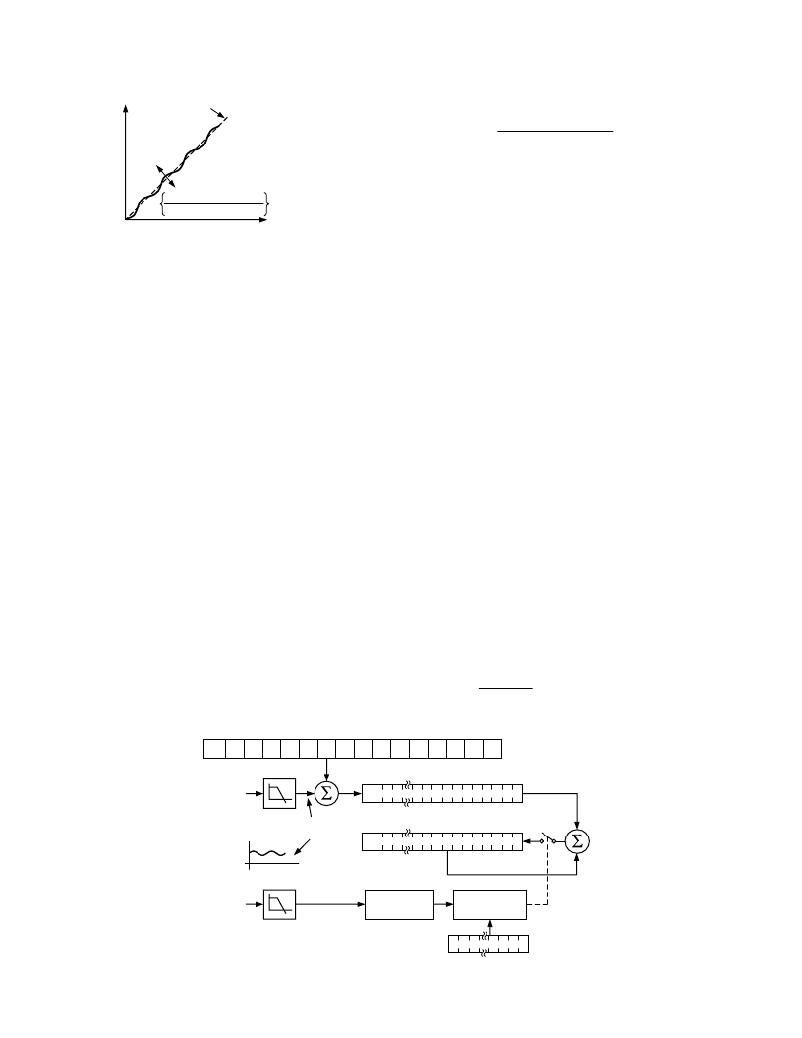- 您现在的位置:买卖IC网 > Sheet目录1214 > EVAL-ADE7759EBZ (Analog Devices Inc)BOARD EVALUATION FOR ADE7759
�� ���
���
 ���
���ADE7759�
�?� VI� ?� nT�
�?� ?� 4� f� l� l� f� /� 8� .� 9� Hz� )� ?� ?� 0�
�(� 1� +� 2�
�E(t)�
�Vlt�
�From� Equations� 5� and� 11:�
�nT�
�E� (� t� )� =� ∫� VIdt� –� ?� ?� ∫� cos� (� 2� wt� )� dt� (13)�
�0�
�where� n� is� an� integer� and� T� is� the� line� cycle� period.�
�Since� the� sinusoidal� component� is� integrated� over� an� integer�
�sin(4� ?� l� t� )�
�VI�
�–�
�4� ?� l� (1� +� 2� ?� l� /8.9Hz)�
�Figure� 39.� Output� Frequency� Ripple�
�LINE� CYCLE� ENERGY� ACCUMULATION� MODE�
�number� of� line� cycles,� its� value� is� always� zero.� Therefore:�
�nT�
�E� (� t� )� =� ∫� VIdt� +� 0�
�0�
�E� (� t� )� =� VInT�
�(14)�
�(15)�
�In� line� cycle� energy� accumulation� mode,� the� energy� accumula-�
�tion� of� the� ADE7759� can� be� synchronized� to� the� Channel� 2� zero�
�crossing� so� that� active� energy� can� be� accumulated� over� an� inte-�
�gral� number� of� half� line� cycles.� The� advantage� of� summing� the�
�active� energy� over� an� integer� number� of� half-line� cycles� is� that�
�the� sinusoidal� component� in� the� active� energy� is� reduced� to� zero.�
�This� eliminates� any� ripple� in� the� energy� calculation.� Energy� is�
�calculated� more� accurately� and� in� a� shorter� time� because� the�
�integration� period� can� be� shortened.� By� using� the� line� cycle�
�energy� accumulation� mode,� the� energy� calibration� can� be� greatly�
�simplified� and� the� time� required� to� calibrate� the� meter� can� be� sig-�
�nificantly� reduced.� The� ADE7759� is� placed� in� line� cycle� energy�
�accumulation� mode� by� setting� Bit� 7� (CYCMODE)� in� the� mode�
�register.� In� line� cycle� energy� accumulation� mode� the� ADE7759�
�accumulates� the� active� power� signal� in� the� LENERGY� register�
�(Address� 14h)� for� an� integral� number� of� half� cycles,� as� shown� in�
�Figure� 40.� The� number� of� half-line� cycles� is� specified� in� the�
�LINECYC� register� (Address� 14h).� The� ADE7759� can� accumu-�
�late� active� power� for� up� to� 16,383� half� cycles.� Because� the� active�
�power� is� integrated� on� an� integral� number� of� half-line� cycles,� at�
�the� end� of� a� line� cycle� energy� accumulation� cycle,� the� CYCEND�
�flag� in� the� interrupt� status� register� is� set� (Bit� 2).� If� the� CYCEND�
�enable� bit� in� the� interrupt� enable� register� is� enabled,� the� IRQ�
�output� will� also� go� active� low.� Thus� the� IRQ� line� can� also� be�
�used� to� signal� the� completion� of� the� line� cycle� energy� accumula-�
�tion.� Another� calibration� cycle� will� start� as� long� as� the� CYCMODE�
�bit� in� the� mode� register� is� set.� Note� that� the� result� of� the� first�
�Note� that� in� this� mode,� the� 14-bit� LINECYC� register� can� hold� a�
�maximum� value� of� 16,383.� In� other� words,� the� line� cycle�
�energy� accumulation� mode� can� be� used� to� accumulate� active�
�energy� for� a� maximum� duration� over� 16,383� half-line� cycles.� At�
�60� Hz� line� frequency,� it� translates� to� a� total� duration� of� 16,383/�
�120� Hz� =� 136.5� seconds.� The� 40-bit� signed� LENERGY� register�
�can� overflow� if� large� signals� are� present� at� the� inputs.� The�
�LENERGY� register� can� only� hold� up� to� 11.53� seconds� of� active�
�energy� when� both� its� input� channels� are� at� ac� full-scale—see�
�Integration� Time� Under� Steady� Load� section.� Large� LINECYC�
�content� is� meant� to� be� used� only� when� the� input� signal� is� low�
�and� extensive� averaging� is� required� to� reduce� the� noise.�
�CALIBRATING� THE� ENERGY� METER�
�Calculating� the� Average� Active� Power�
�When� calibrating� the� ADE7759,� the� first� step� is� to� calibrate� the�
�frequency� on� CF� to� some� required� meter� constant,� e.g.,�
�3200� imp/kWh.�
�To� determine� the� output� frequency� on� CF,� the� average� value� of�
�the� active� power� signal� (output� of� LPF2)� must� first� be� deter-�
�mined.� One� convenient� way� to� do� this� is� to� use� the� line� cycle�
�energy� accumulation� mode.� When� the� CYCMODE� (Bit� 7)� bit�
�in� the� mode� register� is� set� to� a� Logic� 1,� energy� is� accumulated�
�over� an� integer� number� of� half-line� cycles� as� described� in� the�
�last� section.� Since� the� line� frequency� is� fixed� at,� say,� 60� Hz,� and�
�the� number� of� half� cycles� of� integration� is� specified,� the� total�
�integration� time� is� given� as:�
�calibration� is� invalid� and� should� be� ignored.� The� result� of� all�
�subsequent� line� cycle� accumulation� is� correct.�
�1�
�2� � 60� Hz�
�� number� of� half� cycles�
�15�
�APOS� [15:0]�
�0�
�SIGN�
�2� 6�
�2� 5�
�2� 4�
�2� 3�
�2� 2�
�2� 1�
�2� 0�
�2� –1� 2� –2� 2� –3� 2� –4� 2� –5� 2� –6� 2� –7� 2� –8�
�LPF2�
�+�
�23�
�WAVEFORM� [23:0]�
�0�
�FROM�
�MULTIPLIER�
�+�
�ACTIVE� POWER�
�SIGNAL� –� P�
�39�
�LENERGY� [39:0]�
�0�
�+�
�CCCDh�
�00h�
�LPF1�
�+�
�CHANNEL� 2�
�ADC�
�ZERO� CROSS�
�DETECT�
�CALIBRATION�
�CONTROL�
�LINECYC� [13:0]�
�Figure� 40.� Energy� Calculation� in� Line� Cycle� Energy� Accumulation� Mode�
�–24� –�
�REV.� A�
�发布紧急采购,3分钟左右您将得到回复。
相关PDF资料
EVAL-ADE7762EBZ
BOARD EVALUATION FOR ADE7762
EVAL-ADE7763ZEB
BOARD EVALUATION FOR ADE7763
EVAL-ADE7816EBZ
BOARD EVALUATION FOR ADE7816
EVAL-ADE7878EBZ
BOARD EVAL FOR ADE7878
EVAL-ADE7880EBZ
BOARD EVAL FOR ADE7880
EVAL-ADE7953EBZ
BOARD EVAL FOR ADE7953
EVAL-ADF4002EBZ1
BOARD EVAL FOR ADF4002
EVAL-ADG788EBZ
BOARD EVALUATION FOR ADG788
相关代理商/技术参数
EVAL-ADE7762EBZ
功能描述:BOARD EVALUATION FOR ADE7762 RoHS:是 类别:编程器,开发系统 >> 评估演示板和套件 系列:- 标准包装:1 系列:- 主要目的:电信,线路接口单元(LIU) 嵌入式:- 已用 IC / 零件:IDT82V2081 主要属性:T1/J1/E1 LIU 次要属性:- 已供物品:板,电源,线缆,CD 其它名称:82EBV2081
EVAL-ADE7763EB
制造商:Analog Devices 功能描述:EVALUATION BOARD DOCUMENTATION ADE7763 ENERGY METERING IC
EVAL-ADE7763ZEB
功能描述:BOARD EVALUATION FOR ADE7763 RoHS:是 类别:编程器,开发系统 >> 评估演示板和套件 系列:- 标准包装:1 系列:PSoC® 主要目的:电源管理,热管理 嵌入式:- 已用 IC / 零件:- 主要属性:- 次要属性:- 已供物品:板,CD,电源
EVAL-ADE7816EBZ
功能描述:BOARD EVALUATION FOR ADE7816 RoHS:是 类别:编程器,开发系统 >> 评估演示板和套件 系列:- 标准包装:1 系列:PSoC® 主要目的:电源管理,热管理 嵌入式:- 已用 IC / 零件:- 主要属性:- 次要属性:- 已供物品:板,CD,电源
EVAL-ADE7854EBZ
制造商:Analog Devices 功能描述:EVALUATION BOARDS - Boxed Product (Development Kits)
EVAL-ADE7858EBZ
制造商:AD 制造商全称:Analog Devices 功能描述:Poly Phase Multifunction Energy Metering IC with per Phase Active and Reactive Powers
EVAL-ADE7878EBZ
功能描述:BOARD EVAL FOR ADE7878 RoHS:是 类别:编程器,开发系统 >> 评估演示板和套件 系列:- 标准包装:1 系列:PCI Express® (PCIe) 主要目的:接口,收发器,PCI Express 嵌入式:- 已用 IC / 零件:DS80PCI800 主要属性:- 次要属性:- 已供物品:板
EVAL-ADE7880EBZ
功能描述:BOARD EVAL FOR ADE7880 RoHS:是 类别:编程器,开发系统 >> 评估演示板和套件 系列:* 产品培训模块:Obsolescence Mitigation Program 标准包装:1 系列:- 主要目的:电源管理,电池充电器 嵌入式:否 已用 IC / 零件:MAX8903A 主要属性:1 芯锂离子电池 次要属性:状态 LED 已供物品:板